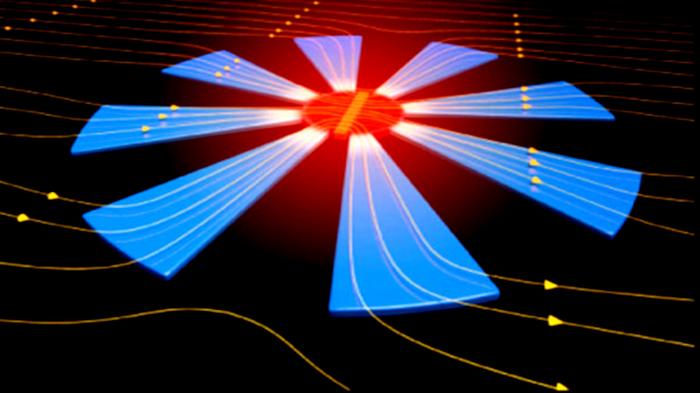In a groundbreaking development that intersects the realms of materials science and magnetism, a research team led by Dr. Anna Palau at the Institut de Ciencia de Materials de Barcelona (ICMAB) has introduced a novel class of magnetic metamaterials. These materials, resembling delicate microflowers, possess the remarkable ability to concentrate and amplify magnetic fields, presenting unprecedented opportunities for technological advancement in magnetic sensing and related fields. This innovative structure is not just an aesthetic marvel; it represents a significant leap in how we can manipulate magnetic forces at microscopic levels.
The flower-like microstructures, composed of nickel-iron alloy, exemplify a new direction in metamaterial research. By carefully designing these microflowers with varying geometries and petal configurations, the research team demonstrates the manipulation of magnetic field lines, producing a localized enhancement of magnetic effects. The critical advantage of these structures lies in their tunability; researchers can dictate the strength and concentration of the magnetic field by modifying the shape and number of petals. This control opens the door to a multitude of applications, particularly in enhancing the performance of magnetic sensors.
Metamaterials are defined as artificially engineered materials designed to exhibit properties not found in nature. The microstructures developed by Dr. Palau’s team fall into this classification, with dimensions smaller than the wavelengths of the electromagnetic and thermal waves they aim to manipulate. The profound implications of such advancements cannot be overstated, as they pioneers the path toward creating materials that can revolutionize sectors ranging from data storage to biomedicine.
In traditional magnetic applications, achieving a substantial magnetic field often involves considerable input energy. However, these innovative metamaterials present a dual advantage: they not only amplify the magnetic field but do so while minimizing the energy expenditure. This capability is particularly relevant in the context of magnetic sensors, where sensitivity is paramount. The ability to detect weaker magnetic fields with increased precision can significantly impact various fields, including medical diagnostics and environmental monitoring.
Dr. Palau’s research has been further validated through collaborative efforts that took place at BESSY II, a synchrotron radiation facility known for its advanced experimental capabilities. Together with her team, she investigated the magnetic properties of these flower-shaped structures at the XPEEM experimental station. By placing a cobalt rod at the center of these microflowers, the research team mapped the resultant magnetic domains while adjusting various geometric parameters. The findings underscored a remarkable increment in sensor sensitivity, demonstrating that the metamaterial design could enhance performance by over two orders of magnitude.
This research holds significant implications for the future development of multifunctional magnetic components and small magnetic sensors. The localized enhancement of magnetic fields through these microstructures could lead to breakthroughs in imaging techniques and sensor technologies, which have yet to reach their full potential. With the current limitations faced in achieving higher magnetic fields during experimental applications at facilities like BESSY II, the introduction of such metamaterials could shift the paradigm.
Moreover, the ability to generate localized, high magnetic fields is crucial for studies examining complex magnetic systems. Traditionally, the maximum magnetic field strength achievable in certain experiments has hovered around 25 millitesla. However, the implementation of these concentrators suggests that researchers could easily exceed this limit, opening the door to previously unattainable experimental conditions. These advancements may lead to enhanced understanding and manipulation of magnetic properties in various materials.
The impact of this study extends beyond theoretical implications; it charts a course for real-world applications that could enhance the efficacy of existing technologies. Industries such as telecommunications, where sensitive magnetic sensors are critical, stand to benefit from the advancements made possible by this metamaterial research. The design principles underlying these microstructures may also inspire innovations in other fields, including energy storage and transmission, where efficiency is crucial.
As the research gains traction, it has the potential to influence the scientific community’s approach to material design, urging a shift towards more complex geometries and structures that can harness the power of magnetic fields more effectively. By bridging the gap between theoretical research and practical application, Dr. Palau’s work serves as a beacon of innovation in the field of materials science. The future of magnetic sensors and their applications may be transformed as researchers continue to explore the capabilities of these novel metamaterials.
The collaboration between different research institutions exemplifies the interdisciplinary nature of modern scientific endeavors. By combining expertise in materials science, physics, and engineering, the team has successfully created a device that could redefine how we engage with and utilize magnetic fields in technology. As further studies unfold, the potential for collaboration across various disciplines promises exciting developments in the near future.
In conclusion, the advancements presented by Dr. Anna Palau and her colleagues in the field of magnetic metamaterials signal an important evolution in our understanding and application of magnetism. These innovative structures not only enhance existing technologies but also pave the way for future explorations of magnetic properties that remain untapped. With continued research and development, we may soon witness the integration of these groundbreaking materials into everyday applications, revolutionizing sectors reliant on magnetic sensing and field manipulation.
The implications of this research stretch far beyond the immediate applications, suggesting a future where the miniaturization of technology continues at an unprecedented rate, underpinned by novel materials with capabilities unheard of just a few years ago. As we navigate this new territory of scientific discovery, the pursuit of knowledge and innovation remains an inspiring journey.
Subject of Research: Not applicable
Article Title: On-Chip Planar Metasurfaces for Magnetic Sensors with Greatly Enhanced Sensitivity
News Publication Date: 6-Mar-2025
Web References: 10.1021/acsnano.5c00422
References: None
Image Credits: A. Palau/ICMAB
Keywords: Metamaterials, Magnetic fields, Sensors, Geometry, Alloys, Microstructures, Ferromagnetism.




